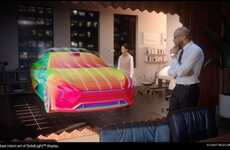
Synthetic Reality Concept
Jeremy Gutsche — May 14, 2007 — Tech
References: cs.cmu.edu & techeblog
This captivating video about programmable matter combines the prototyping technology of the next century with background music from the last. Despite the horrible tune, the imagery in the video is captivating. "Bring your idea to the table and take shape form and colour. Rendered dynamically from 3D data, you can now touch it, feel it and mold it in your hands. A programmable matter that transforms your imagination into reality."
The idea, also called Claytronics, could be used in a wide range of applications, including military. Accordingly, DARPA is all over it, already supporting research projects at Carnegie Mellon. Their website describes, "The goal of the claytronics project is to understand and develop the hardware and software necessary to create a material which can be programmed to form dynamic three dimensional shapes which can interact in the physical world and visually take on an arbitrary appearance. Claytronics refers to an ensemble of individual components, called catoms—for claytronic atoms—that can move in three dimensions (in relation to other catoms), adhere to other catoms to maintain a 3D shape, and compute state information (with possible assistance from other catoms in the ensemble). Each catom contains a CPU, an energy store, a network device, a video output device, one or more sensors, a means of locomotion, and a mechanism for adhering to other catoms."
So this leaves me with just one question: I would like to shape shift bike into a Lamborghini. Can it do that?
The idea, also called Claytronics, could be used in a wide range of applications, including military. Accordingly, DARPA is all over it, already supporting research projects at Carnegie Mellon. Their website describes, "The goal of the claytronics project is to understand and develop the hardware and software necessary to create a material which can be programmed to form dynamic three dimensional shapes which can interact in the physical world and visually take on an arbitrary appearance. Claytronics refers to an ensemble of individual components, called catoms—for claytronic atoms—that can move in three dimensions (in relation to other catoms), adhere to other catoms to maintain a 3D shape, and compute state information (with possible assistance from other catoms in the ensemble). Each catom contains a CPU, an energy store, a network device, a video output device, one or more sensors, a means of locomotion, and a mechanism for adhering to other catoms."
So this leaves me with just one question: I would like to shape shift bike into a Lamborghini. Can it do that?
Trend Themes
1. Programmable Matter - The concept of programmable matter opens up opportunities for disruptive innovation in various industries.
2. Claytronics - The application of claytronics technology has the potential to revolutionize industries by enabling dynamic three-dimensional shapes and interactions.
3. Shape-shifting Technology - The development of shape-shifting technology presents disruptive innovation possibilities for industries looking to transform objects into different forms.
Industry Implications
1. Manufacturing - Programmable matter and claytronics can revolutionize the manufacturing industry by allowing for flexible and customizable product designs.
2. Defense - The military industry can benefit from claytronics and programmable matter for applications such as adaptive camouflage and shape-shifting weapons.
3. Transportation - The transportation industry could explore the use of shape-shifting technology to create versatile vehicles that adapt to different needs and environments.
4.3
Score
Popularity
Activity
Freshness















